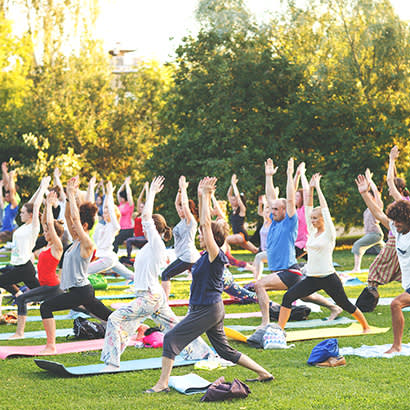
For an enhanced digital experience, read this story in the ezine.
Discovering why we connect with parks and recreation
To better understand how and why people connect with parks and recreation, NRPA conducted its annual Engagement With Parks survey. This year’s survey results, released in November, continue to show that parks and recreation is a valuable public service supporting the health and well-being, social connection, education, and family care of millions nationwide.
Access to Parks and Recreation
Millions of people in the United States access local park and recreation facilities.
The Engagement With Parks Report shows that 82 percent of respondents, the equivalent of more than 276 million people, visited a park and recreation facility at least once during the past year. These results highlight parks and recreation as a vital and recognized resource within communities.
Living near parks and recreation is important for most U.S. adults.
Most survey respondents (73 percent) live within a walkable distance to at least one park or recreation facility. Many residents desire this close access, with 86 percent of respondents saying that proximity to high-quality parks, playgrounds, open spaces or other recreation facilities is important when choosing an area in which to live.
Use of Parks and Recreation
Residents use parks and recreation in a variety of ways.
The top uses of parks and recreation by the millions of visitors in the past year were visiting a local park, playground, dog park or other local open space (76 percent) and using a hiking, biking or walking trail (53 percent). Survey respondents also played sports independently or in a league (47 percent), used aquatics centers (31 percent), used recreation centers (23 percent), and took part in recreation center classes, lessons or activities (17 percent). Of parents, 33 percent reported their children participated in out-of-school time programs.
People use parks and recreation for social, physical, emotional and intellectual well-being.
The top reasons for using parks and recreation facilities and programming cited by greater than 50 percent of survey respondents were to be with family or friends, to exercise, and to have a break from day-to-day stresses. Other reasons included: to be close to nature (49 percent), to experience excitement/adventure (30 percent), to connect with community (23 percent), and to learn a skill or craft (11 percent).
People experiencing inclusion and belonging use parks and recreation more often than those who do not.
While 97 percent of respondents reported at least one experience of inclusion and belonging at their park and recreation spaces, these experiences varied among respondents. For example, compared to other generations, baby boomers were more likely to feel inclusion and belonging. In terms of race/ethnicity, people identifying as white were more likely to have these experiences than people of color or those identifying as Hispanic. Experiences also varied by income, with people in a higher income bracket feeling inclusion and belonging more than those with lower incomes.
People who experience safe, accessible and inclusive park and recreation spaces visit those places more often, on average, than those who do not have those experiences.
Value of Parks and Recreation
Nine in 10 U.S. adults agree parks and recreation is a valuable service their local governments provide and should be sufficiently funded.
Nine in 10 (91 percent) U.S. adults agree parks and recreation is a valuable service their local governments provide, as much as fire, road/transportation, water/utilities, health and police. Most (92 percent) respondents believe local and state governments should sufficiently fund parks and recreation to ensure every community member has access to amenities, infrastructure and programming.
The full Engagement With Parks Report offers additional insights into these results and more. Check it out at nrpa.org/Research.
Author’s Note: Thank you to the 1,000 U.S. adults who contributed to this survey.
Samantha Serrano is Senior Research and Evaluation Manager at NRPA.


